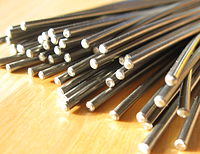
Photo from wikipedia
An increase in the use of Computer-Aided Design (CAD) and Computer-Aided Manufacturing (CAM) technologies challenges the conventional prosthetic fabrication procedures that are practical and centered on a digital workflow for… Click to show full abstract
An increase in the use of Computer-Aided Design (CAD) and Computer-Aided Manufacturing (CAM) technologies challenges the conventional prosthetic fabrication procedures that are practical and centered on a digital workflow for the patient, especially for dental implants. Increasing workflow of digital restoration work, considering computer-used CAM for restoration technology systems and also fast/CAM for building restoration technology; fast/CAD, also known as abut-Base, has increased interest. Studies on adaptation of different restorative materials, on titanium (Ti)-base abutments, traction, and transformed cycling have become relevant. The objective of this work was to research, through literature studies, on restoration-type abutments. A total of 24 articles were found after searching the following terms in PubMed/Medline, Scopus, and Embase databases: "ti-base AND abutment." Twenty-one manuscripts selected from the inclusion and exclusion criteria. After an analysis of these articles, it was concluded that the Ti-base abutment and components from the same manufacturer as the Implant should be used preferably; milled monolithic crowns designed to adapt to the Ti-base the hybrid abutment-crown assembly does not affect torque maintenance after thermal aging; the saliva and cleaning protocol of the Ti-base bonding surfaces can influence the operations of the Ti-base crowns; Ti-base and Crown surface treatment is recommended for better applicability and stability results, and the superiority of resin-based cements compared with other types of cements.
Journal Title: European journal of dentistry
Year Published: 2022
Link to full text (if available)
Share on Social Media: Sign Up to like & get
recommendations!